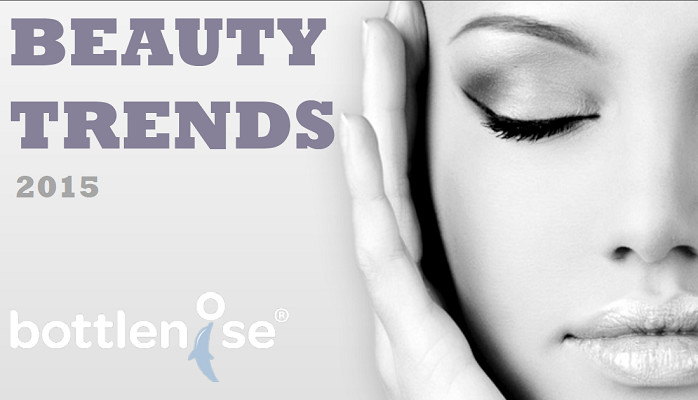
What This Year's Beauty Trends Can Teach Us About Disruption
The latest Bottlenose market report is about beauty products. I paged through our analysis of the relevant social media trends, expecting to learn something about lipstick colors and cruelty-free testing policies, and I did. But the big takeaway surprised me because of how universal it is.
In Beauty, as elsewhere in our rapidly shifting economy, the hot areas and potential disruptions seem to be 1) do-it-yourself (DIY) and 2) emerging fleets of on-demand workers (in this case, beauticians) summoned by a smartphone app.
It’s Beauty’s version of the Maker Movement vs. crowd-sourced demand gratification. Not to be derisive, but call the latter the Taker Movement.
Nailing a Maker Movement
I had noted Beauty’s DIY ethos in the nails of my female acquaintances. My suburban LA neighborhood is full of nail salons. But my artistic friends proudly showcase their own nail artwork or that of their daughters online. And, sure enough, “DIY nail art” is a common theme in “beauty trends for 2015” opinion pieces.
Makers aren’t into DIY to save money. Rather, they have a yearning to express themselves in what they can make or do, or learn to make or do, empowered by technology.
It’s not about technology devices themselves, certainly. Take what L’oreal discovered when they came up with a clever and seemingly very useful DIY application of Google Glass. Have the makeup artist wear Google Glass and send the customer home with a behind-the-brush video view of how to apply her makeup.
The story of Google Glass going into salons resulted in a spike of social media conversation. That’s to be expected when content providers with large followings push something. Yahoo!Beauty and InStyle drove buzz.
But the grass roots conversation was negative (#kickintheglass) and faded quickly. Our analysts read the psychographic tea leaves of the online conversation to determine why. As they put it in their Beauty Trend report: “Beauty + Technology = Power.” It’s not about devices. When something helps consumers express their inner beauty, you have a winner.
Mink is a Case In Point
Do-It-Yourself beauty tech seems to excite interest by its promise of the self-fulfillment of the Maker movement and perhaps even a hint of sticking it to the man.
Take Mink, a modification of standard printers that trended in social for several reasons. Mink allows consumers to pick any color they can find online and print their own creamy lipsticks or eye shadow in that exact shade.
Grace Choi, the entrepreneur behind Mink, is firmly in the Maker realm and maybe a little bit beyond. She has refused venture money in a quest to create a self-empowerment movement. Her goal is to transfer power from the beauty industry to consumers who can make their own makeup in any shade for the cost of printer ink. Definitely disruptive.
On the Flip Side: The Taker Movement
Not so surprising but just as disruptive – maybe more when it comes to beauty salons – are the emerging fleets of on-demand beauty services. Geek Squad, make room for GlamSquad. At least at the luxury end of the market, on-demand wins over do-it-yourself (and, to some as-yet unknown degree, over a trip to the salon).
But I’d like to apply these lessons from the nice bit of work our analysts did on the beauty market a bit more broadly.
DIY’s flip side is the crowd-sourced economy, where people are summoned to do things for you at the touch of a smartphone screen.
As Maker Movement maven and Stanford Professor Barry Katz put it, “We are caught between two opposing forces: Our tendency to produce more and more stuff we are literally drowning in versus our human ability to make things.” In this case, what we are drowning in (in the best sense of that word) is an app for everything and minions willing to do your bidding.
Makers reject the notion that they are defined by what they buy. They have a yearning to express themselves. To be fair, Takers do too, and in offloading what they are not keenly interested in they gain time for self-fulfillment.
In one case, the organizational power of Internet-connected Smartphones creates community-based economies around artisanal craftsmanship and the rejection of consumerism. In the other, an app delivers whatever service or material thing you desire.
Make or Take, the Beauty business is clearly evolving with the rest of our economy. Here's a link to the full report.
Kevin Strehlo is VP of Content and Publishing for Bottlenose, Inc., a Los Angeles-based startup whose current product, Bottlenose® Nerve Center™ is a real-time dashboard for understanding markets, brand health, risk and threat detection, forensics, crisis management, consumer insights, customer analytics, investor relations, and product innovation. Follow us on Facebook and Twitter.
Entrepreneur, Investor, Strategist, Expander, Operator and Pickleball player.
7yany chance I can see the report? the link doesn't work. Super interested in what's happening in this space and how it also might apply to apparel.
Head of Marketing | Advisory Board Member | CSPO | Running relentless 🎯 strategy that converts and ultramarathons 🥷🏻
9yA great read Kevin . Love the notion of the Makers and Takers - sums up the trends well. I read this today which you might like, in a similar vein. https://hbr.org/2015/01/the-sharing-economy-isnt-about-sharing-at-all It's about the sharing economy proposing it is about taking and price - not the sharing with others at all.
Married to Digital Marketing & FinTech, An Author who loves to write about Disruptive Innovations
9ykevin.. I'd love to read the full report as well..really loved it
Managing Director at Wolfram Publications
9yThanks for sharing